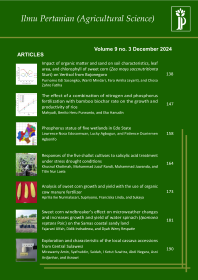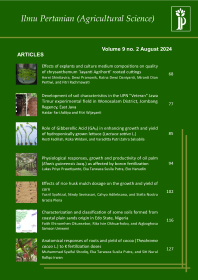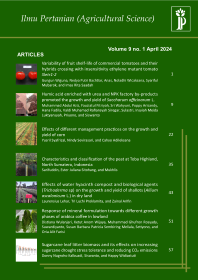
Effects of cropping system and varieties on the rice growth and yield in acid sulphate soils of tidal swampland
Izhar Khairullah(1*), Wahida Annisa(2), Herman Subagio(3), Hendri Sosiawan(4)
(1) Indonesian Swampland Agricultural Research Institute (ISARI) Jl. Kebun Karet, Loktabat Utara PO BOX 31, Banjarbaru 70712, Kalimantan Selatan, Indonesia
(2) Indonesian Swampland Agricultural Research Institute (ISARI) Jl. Kebun Karet, Loktabat Utara PO BOX 31, Banjarbaru 70712, Kalimantan Selatan, Indonesia
(3) Assessment Institute for Agricultural Technology (AIAT) East Java Jl. Raya Karangploso Km. 4 PO Box 188 Malang 65101, East Java, Indonesia
(4) Indonesian Agroclimate and Hydrology Research Institute (IAHRI) Jl. Ir. H. Juanda No. 98, Bogor 16123, West Java, Indonesia
(*) Corresponding Author
Abstract
Swampland plays a critical function in agriculture, specifically in growing rice production. The study aimed to determine the effects of cropping systems and varieties on the rice growth and yield in acid sulfate soil of tidal swampland. The experiment was conducted in a potential acid sulphate soils in Kapuas Regency, Central Kalimantan Province. The experiment was arranged in a split plot design with three replications. The main plot consisted of three HYV’s of rice, namely Inpara 8, Inpari 32, and Margasari. The subplot consisted of five cropping systems, namely, Jarwo 2:1A, Jarwo 2:1B, Jarwo 2:1C, Hazton, and Tegel. The plot size was 4 m x 5 m. The variables observed included initial soil properties, plant growth, and yield components. The jajar legowo cropping system in this study was not able to increase rice yields in acid sulphate soil. There was an interaction effect of cropping systems and varieties on the plant height and number of tillers at vegetative phase. At generative and pre-harvest phases, there was significant single effect of variety and cropping system in the planting height and number of tillers, respectively. Both cropping system and variety significantly affected the number of panicles per hill, while panicle length, grain per panicle and grain yield were only affected by variety. There was no significant effect of both factors on the number of filled grains per panicle. Inpara 8 variety achieved the highest grain yield, which was 6.78 ton.ha-1 or equivalent to 4.34 ton.ha-1 of 14 % water content.
Keywords
Full Text:
PDFReferences
Aribawa, I.B. (2012). Pengaruh sistem tanam terhadap peningkatan produktivitas padi di lahan sawah dataran tinggi beriklim basah. Seminar Nasional Kedaulatan Pangan dan Energi, Fakultas Pertanian, Universitas Trunojoyo.
Aslam, M., Hussain, S., Ramzan, M., and Akhter, M. (2008). Effect of different stand establishment techniques on rice yields and its attributes. J. Anim. Pl. Sci., 18(2–3), pp. 80-82.
Awan T.H., Ali, R.I., Manzoor, Z., Ahmad, M., and Akhtar, M. (2011). Effect of different nitrogen levels and row spacing on the performance of newly evolved medium grain rice variety, KSK-133. J. Anim. Pl. Sci., 21(2), pp. 231–234.
Balai Penelitian dan Pengembangan Pertanian. (2015). Panduan teknologi budidaya hazton pada tanaman padi. 1st ed. Jakarta: Badan Penelitian dan Pengembangan Pertanian, Kementerian Pertanian, pp. 20.
Baloch, M.S., Awan, I.U., Jatoi, S.A., Hussain, I., and Khan, B. (2000). Evaluation of seeding densities in broadcast wet seeded rice. J. Pure and Applied Sci., 19(1), pp. 63–65.
Christanto, H. and Agung, I.G.A.M.S. (2014). Jumlah bibit per lubang dan jarak tanam berpengaruh terhadap hasil padi gogo (Oryza sativa L.) dengan system of rice intensification di lahan kering. J. Bumi Lestari, 14(11), pp. 1-8.
Haryono, Noor, M., Syahbuddin, H., Sarwani, M. (2013). Lahan rawa: penelitian dan pengembangan. 2nd ed. Jakarta: IAARD Press, pp. 103.
Hatta, M. (2011). Pengaruh tipe jarak tanam terhadap anakan, komponen hasil, dan hasil dua varietas padi pada metode SRI. J. Floratek, 6(2), pp. 104-113.
Hatta, M. (2012). Jarak tanam sistem legowo terhadap pertumbuhan dan hasil beberapa varietas padi pada metode SRI. Jurnal Agrista, 16(2), pp. 87-93.
Hayashi S., Kamoshita, A., Yamagishi, J., Kotchasatit, A., and Jongdee, B. (2007). Genotypic differences in grain yield of transplanted and direct-seeded rainfed lowland rice (Oryza sativa L.) in northeastern Thailand. Field Crop Res., 102(1), pp. 9–21.
Ikehashi, H and F. N. Ponnamperuma. (1978). Varieties tolerance of rice for adverse soils: Soil and Rice. Los Banos, Philippines: International Rice Experiment Institute, pp. 801-823.
Ikhwani and A.K. Makarim. 2012. Respons varietas padi terhadap perendaman, pemupukan dan jarak tanam. J. Pen. Pert. Tan. Pangan, 31(2), p. 93-99.
Ikhwani, Pratiwi, G.R., Paturrahman, E., and Makarim, A.K. (2013). Peningkatan produktivitas padi melalui penerapan jarak tanam jajar legowo. Iptek Tanaman Pangan, 8(2), pp. 72–79.
Irmayanti, A. (2011). Respons beberapa varietas padi terhadap dua sistem tanam. Thesis. Tadulako University.
Javaid, T., Awan, I.U., Baloch, M.S., Shah, I.H., Nadim, M.A., Khan, E.A., Khakwani, A.A., and Abuzar, M.R. (2012). Effect of planting methods on the growth and yield of coarse rice. Journal of Animal & Plant Sciences, 22(2), pp. 358-362.
Karokaro, S., Rogi, J.E.X., Runtunuwu, D.S., and Tumewu, P. (2015). Pengaturan jarak tanam paid (Oryza sativa L.) pada sistem tanam jajar legowo. Cocos, 6(16), pp. 1-7.
Kirk, G. (2004). The biogeochemistry of submerged soils. 1st ed. Chichester, UK: John Wiley and Sons, pp. 291.
Kumalasari, S.N., Sudiarso, and Suryanto, A. (2017). Pengaruh jarak tanam dan jumlah bibit pada tanaman padi (Oryza sativa L ) hibrida varietas PP3. Jurnal Produksi Tanaman, 5(7), pp. 1220-1227.
Kurniasih, B., Fatimah, S., and Purnawati, D.A. (2008). Karakteristik perakaran tanaman padi sawah IR64 (Oryza sativa L.) pada umur bibit dan jarak tanam yang berbeda. Ilmu Pertanian (Agricultural Science), 15(1), pp. 15-25.
Lestari, E.G., Guharja, E., Harran, S., and Mariska, I. (2005). Uji daya tembus akar untuk seleksi somaklon toleran kekeringan pada padi varietas Gajah Mungkur, Towuti dan IR64. Penelitian Pertanian Tanaman Pangan, 24(2), pp. 97-103.
Lin, X.Q., Zhu, D.F., Chen, H.Z., and Zhang, Y.P. (2009). Effects of plant density and nitrogen application rate on grain yield and nitrogen uptake of super hybrid rice. Rice Science, 16(2), pp. 138-142.
Makarim, A.K., Pasaribu, D., Zaini, Z. and Las, I. (2005). Analisis dan sintesis pengembangan model pengelolaan tanaman terpadu padi sawah. Jakarta: Balai Penelitian Tanaman Padi, pp. 18.
Mobasser, H.R., Yadi, R., Azizi, M., Ghanbari, A.M., and Samdalari, M. (2009). Effect of density on morphological characteristics related-lodging on yield and yield components in varieties rice (Oryza sativa L.) in Iran. American-Eurasian Journal of Agriculture and Environmental Science, 5(6), pp. 745-754.
Mulyaningsih. (2008). Perbandingan analisis pendapatan SRI (System of Rice Intensification) dengan system konvensional. Undergraduated Thesis. Lampung University.
Muyassir. (2012). Efek jarak tanam, umur, dan jumlah bibit terhadap hasil padi sawah (Oryza sativa L.). Jurnal Manajemen Sumberdaya Lahan, 1(2), pp. 207-212.
Nurshanti, R. (2008). Pengaruh umur bibit dan jarak tanam terhadap pertumbuhan dan produktivitas Tanaman Buru Hotong (Setaria italica (L.) Beauv.). Undergraduated Thesis. IPB University.
Ottow, J.C.G., Benckiser, G., and Watanabe, I. (1982). Iron toxicity of rice as a multiple nutrition soil stress. Tropical Agriculture Research Series : Proceedings of a Symposium on Tropical Agriculture Researches, pp. 167-179.
Paulina U., Syarif, A., and Anwar, A. (2020). Strategy for development of rice sawah culture planting in jarwo plants with various modification of plant distance. International Journal of Environment, Agriculture and Biotechnology, 5(1), pp. 174-180.
Pinem, A.H., Barus, A., and Hanum, C. (2013). Efektifitas jarak tanam dan jumlah benih per lubang tanam terhadap pertumbuhan dan produksi padi gogo. J. Online Agroekoteknologi, 1(4), pp. 921-929.
Prade, K., Ottow, J. C. G., Jacq, V., Malouf, G., and Loyer, J.Y. (1990). Relationships between the properties of flooded rice soils and iron toxicity in Lower Casamance (Senegal). Studies, review and summary of previous work. Cashiers ORSTOM, serie Pedologie. Montpellier, France: IRD, pp. 453-474.
Pratiwi, G.R., Suhartatik, E., and Makarim, A.K. (2010). Produktivitas dan komponen hasil tanaman padi sebagai fungsi dari populasi tanaman. In: Abdulrachman, S. et al. (eds.). Inovasi Teknologi Padi untuk Mempertahankan Swasembada dan Mendorong Ekspor Beras. Prosiding Seminar nasional Hasil Penelitian Padi 2009. 2nd ed. Jakarta: Balai Besar Penelitian Tanaman Padi. pp.443-450.
Rahimi, Z., Zuhry, E., and Nurbaiti. (2011). Pengaruh jarak tanam terhadap pertumbuhan dan produksi padi sawah (Oryza sativa L.) varietas Batang Piaman dengan Metode SRI di Padang Marpoyan. [online]. Available at: https://repository.unri.ac.id/xmlui/bitstream/handle/123456789/1608/JURNAL%20ZUHDI%20RAHIMI.pdf?sequence=1&isAllowed=y. [Accessed 07 Dec 2020).
Rauf, A.W., Tohari, Yudono, P., and Kabirun, S. (2005). Pengaruh alelopati padi terhadap pertumbuhan dan hasil kedelai pada sistem tanam berurutan padi kedelai. Penelitian Pertanian Tanaman Pangan, 24(2), pp. 76-84.
Ritung, S., Suryani, E., Subardja, D., Sukarman, Nugroho, K., Suparto, Hikmatullah, Mulyani, A., Tafakresnanto, C., Sulaeman, Y., Subandiono, R.E., Wahyunto, Ponidi, Prasodjo, N., Suryana, U., Hidayat, H., Priyono, A., and Supriatna, W. (2014). Sumberdaya lahan pertanian Indonesia: luas, penyebaran, dan potensi ketersediaan. Jakarta: IAARD Press, pp. 100.
Sasaki, R., Yamaguchi, H., and Matsuba, K. (1999). Theoretical analysis of the tillering capacity for the lower density of seedling establishment in direct seeding cultivation of rice (Oryza sativa L.). Japanese Journal of Crop Science, 68(1), pp. 10–15.
Sauki, A., Nugroho, A., and Soelistyono, R. (2014). Pengaruh jarak tanam dan waktu penggenangan pada metode SRI (System Of Rice Intensification) terhadap pertumbuhan dan hasil tanaman padi (Oryza sativa L.). Jurnal Produksi Tanaman, 2(3),pp. 121-127.
Sohel, M.A.T., Siddique, M.A.B., Asaduzzaman, M., Alam, M.N., and Karim, M.M. (2009). Varietal performance of transplant aman rice under different hill densities. Bangladesh J. Agric. Res., 34(1), pp. 33-39.
Suardi, D. and Moeljopawiro, S. (1999). Daya tembus akar sebagai kriteria seleksi ketahanan kekeringan pada padi: I. Pengaruh tingkat kekerasan dan ketebalan lapisan media campuran paraffin dan vaselin terhadap daya tembus akar. Penelitian Pertanian Tanaman Pangan, 18(1), pp. 29-34.
Suhartatik, E., Makarim, A.K., and Ikhwani. (2011). Respon lima varietas unggul baru terhadap perubahan jarak tanam. Prosiding Seminar Nasional Hasil Penelitian Padi 2011 Inovasi Tekonologi Padi Mengantisipasi Cekaman Lingkungan Biotik dan Abiotik, pp. 1259-1273.
Sunadi. (2008). Modifikasi paket teknologi SRI (System of Rice Intensification) untuk meningkatan hasil padi sawah (Oryza sativa L.). Dissertation. Andalas University.
Supriyanto, E.A, Syakiroh, J., and Wisnu, A. (2010). Pengaruh system tanam legowo dan konsentrasi pupuk pelengkap cair terhadap pertumbuhan dan produksi padi. Biofarm Jurnal Ilmiah Pertanian, 13(8).
Syaiful, S.A., Sennang, N.S., and Yasin, M. (2012). Pertumbuhan dan produksi padi hibrida pada pemberian pupuk hayati dan jumlah bibit per lubang tanam. J. Agrivigor, 11(2), pp. 202-213.
Turmuktini, T., Widodo, W., and Kanta. (2012). Karakterisasi pertumbuhan dan hasil beberapa varietas padi akibat pengaturan jarak tanam yang berbeda di lahan sawah irigasi. CEFARS Jurnal Agribisnis dan Pengembangan Wilayah, 3(2), pp. 19-26.
Wu, H., Pratley, J., Leemerle, D., and Haig, T. (1999). Crop cultivars with allelopathic capability. Weed Research, 39, pp. 171-180.
Yang, S., Sang, Y.U., Tae, P.S., and Tae, C.B. (1998). Physical and yield responses of rice cultivars in direct seeded and transplanted rice cultivation. J. Crop Sci., 40(2), pp. 109–47.
Yetti, H. and Ardian. (2010). Pengaruh penggunaan jarak tanam terhadap pertumbuhan dan produksi padi sawah (Oryza sativa L) varietas IR dengan metode SRI (System of Rice Intensification). Sagu, 9(1), pp. 1-27.
Article Metrics
Refbacks
- There are currently no refbacks.
Ilmu Pertanian (Agricultural Science) ISSN 0126-4214 (print), ISSN 2527-7162 (online) is published by Faculty of Agriculture Universitas Gadjah Mada collaboration with Perhimpunan Sarjana Pertanian Indonesia (PISPI) and licensed under a Creative Commons Attribution-ShareAlike 4.0 International License.













